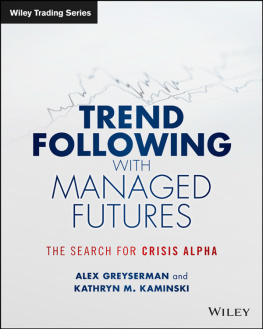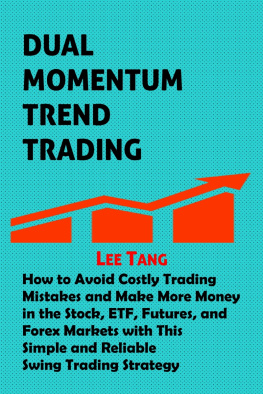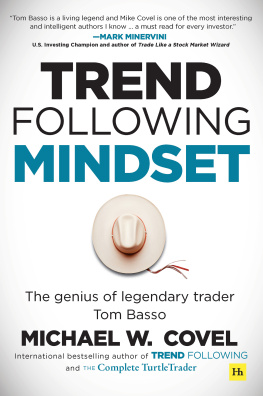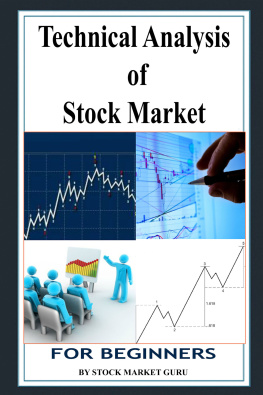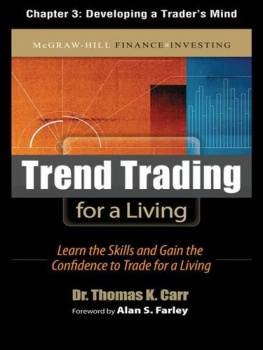T REND F OLLOWING
WITH
M ANAGED F UTURES
The Search for Crisis Alpha
Alex Greyserman
Kathryn Kaminski

T REND F OLLOWING
WITH
M ANAGED F UTURES
Copyright 2014 by Alex Greyserman and Kathryn Kaminski. All rights reserved.
Published by John Wiley & Sons, Inc., Hoboken, New Jersey.
Published simultaneously in Canada.
No part of this publication may be reproduced, stored in a retrieval system, or transmitted in any form or by any means, electronic, mechanical, photocopying, recording, scanning, or otherwise, except as permitted under Section 107 or 108 of the 1976 United States Copyright Act, without either the prior written permission of the Publisher, or authorization through payment of the appropriate per-copy fee to the Copyright Clearance Center, Inc., 222 Rosewood Drive, Danvers, MA 01923, (978) 750-8400, fax (978) 646-8600, or on the Web at www.copyright.com . Requests to the Publisher for permission should be addressed to the Permissions Department, John Wiley & Sons, Inc., 111 River Street, Hoboken, NJ 07030, (201) 748-6011, fax (201) 748-6008, or online at http://www.wiley.com/go/permissions .
Limit of Liability/Disclaimer of Warranty: While the publisher and author have used their best efforts in preparing this book, they make no representations or warranties with respect to the accuracy or completeness of the contents of this book and specifically disclaim any implied warranties of merchantability or fitness for a particular purpose. No warranty may be created or extended by sales representatives or written sales materials. The advice and strategies contained herein may not be suitable for your situation. You should consult with a professional where appropriate. Neither the publisher nor author shall be liable for any loss of profit or any other commercial damages, including but not limited to special, incidental, consequential, or other damages.
For general information on our other products and services or for technical support, please contact our Customer Care Department within the United States at (800) 762-2974, outside the United States at (317) 572-3993 or fax (317) 572-4002.
Wiley publishes in a variety of print and electronic formats and by print-on-demand. Some material included with standard print versions of this book may not be included in e-books or in print-on-demand. If this book refers to media such as a CD or DVD that is not included in the version you purchased, you may download this material at http://booksupport.wiley.com . For more information about Wiley products, visit www.wiley.com .
ISBN 978-1-118-89097-4 (Paperback)
ISBN 978-1-118-89104-9 (ePDF)
ISBN 978-1-118-89102-5 (ePub)
Founded in 1807, John Wiley & Sons is the oldest independent publishing company in the United States. With offices in North America, Europe, Australia and Asia, Wiley is globally committed to developing and marketing print and electronic products and services for our customers professional and personal knowledge and understanding.
The Wiley Trading series features books by traders who have survived the markets ever changing temperament and have prosperedsome by reinventing systems, others by getting back to basics. Whether a novice trader, professional or somewhere in-between, these books will provide the advice and strategies needed to prosper today and well into the future.
For more on this series, visit our Web site at www.WileyTrading.com .
FOREWORD
I t is a rare pleasure and honor for an academic to be asked to write a foreword for a book coauthored by one of his charges, not unlike a parent seeing a child off to college and onto a successful career of her own. However, unlike parenthood, my experience with Katy Kaminski was considerably less challenging because she first showed up at my office more than a decade ago already well-trained in mathematics, statistics, and operations research, and an eager student of finance. Like most MIT students Ive had the privilege of advising over the years, Katy did most of the driving; my role was largely to stay out of her way and cheer her on from the stands.
This bookcoauthored with Alex Greyserman, a seasoned Wall Street veteran and PhD in statisticsis a fascinating and timely examination of an investment strategy that, for too long, has dwelt in the shadows of the financial industry. Trend following has received a bad rap among mainstream investors and portfolio managers for a number of reasons. Perhaps the most obvious is the natural preference for originality in any creative endeavor, whether it be in the arts or the scienceswhy would you want to follow the crowd when you can do something unique?
This instinctive aversion to copycats belies the surprising frequency of copycat strategies found in nature, including herding behavior among most animal species, mimicking abilities such as the color shifting of chameleons, and the high-fidelity nature of DNA replication across eons of time. Among Homo sapiens, trends have also been documented in the spread of technologies such as fire, stone tools, agriculture, and industrialization, not to mention hemlines, low-carb diets, and apps. In the narrow context of financial investments, trends are all too familiar to brokers, financial advisors, and others responsible for marketing new products such as global tactical asset allocation overlays, 130/30 funds, and risk-parity strategies. As certain investment products come into or fall out of favor, trends in asset prices are created by the flow of funds into and out of these products.
But despite the many reasons for trends to exist and persist, there still seems to be an almost religious aversion to trend following investment strategies among certain investors. I believe there are three primary sources for this aversion. The first is the efficient markets hypothesisif trend following really works, everyone would do it, and then wouldnt it stop working? The second is the fact that early trend following strategies were associated with technical analysis or charting, which finance academics equate with voodoo and astrology. And the third is the lack of transparency surrounding trend following strategies, which makes it hard for investors to understand how and when they generate value, why they offer unique diversification benefits, and under what conditions they are likely to underperform more traditional investments.
The first point can be addressed by observing that even if prices do fully reflect all available information instantaneously and costless, trends can still exist if an asset carries a positive risk premium. After all, what is a risk premium but a positive expected excess return, which implies an upward-trending price series! Trend following strategies exploit such risk premia, but are one level more sophisticated than traditional buy-and-hold strategies because they acknowledge that risk premia are time-varying and when trends break, stop-loss policies are used to reduce downside risk. But markets are not always and everywhere efficient, as many academics and industry professionals now recognizeinvestors adapt to changing economic conditions, and trends and reversals are commonplace in adaptive markets.
The second point is an unfortunate aspect of heritage that trend followers cant easily escape, but rather than suffer silently from guilt by association, practitioners can differentiate themselves by articulating a deeper narrative for trend following strategies. And the third point can be addressed by deriving the many investment implications of this deeper narrative such as benchmarking, portfolio construction, style analysis, and performance attribution. This is exactly what Greyserman and Kaminski have done in this exciting volume.

